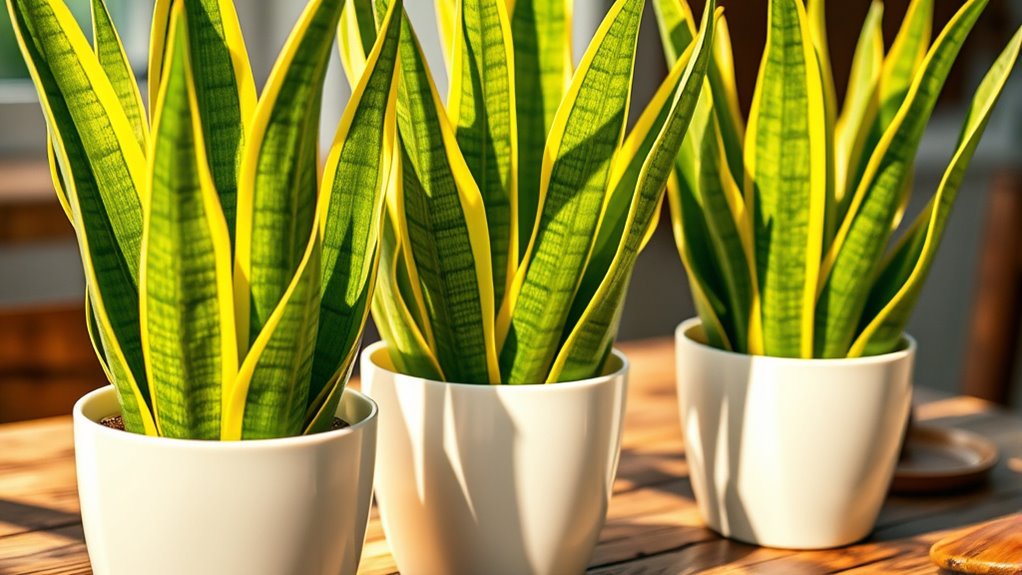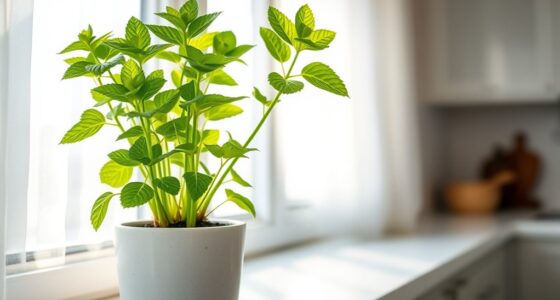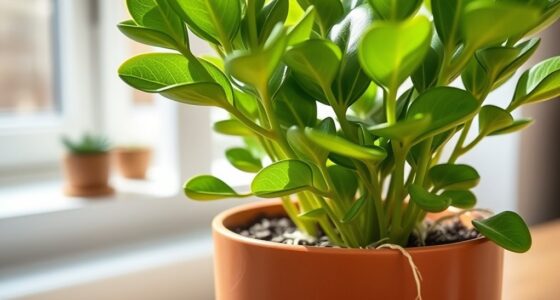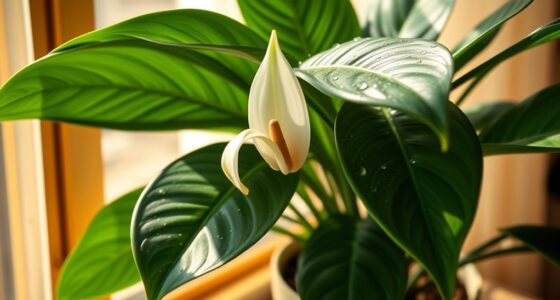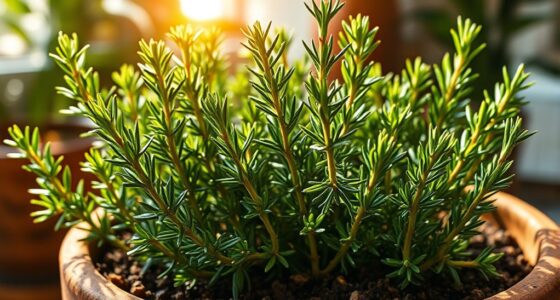To care for your air-purifying snake plant, place it near east- or west-facing windows for bright, indirect light, and water only when the soil is completely dry—about every 2-6 weeks. Use well-draining soil and guarantee the pot has drainage holes. Keep the temperature between 70-90°F and avoid drafts. For pet safety, remember snake plants are toxic if ingested. If you want to learn more, there’s always more to discover about keeping your plant healthy and thriving.
Key Takeaways
- Place snake plants near east- or west-facing windows for 5-6 hours of indirect sunlight daily.
- Water only when the soil is completely dry, approximately every 2-6 weeks, using well-draining soil.
- Keep indoor temperatures between 70°F and 90°F, avoiding drafts and cold spots below 50°F.
- Prevent overwatering and ensure pots have drainage holes to avoid root rot and leaf yellowing.
- Keep pets away, as snake plants are toxic if ingested, and use barriers if necessary.
Optimal Lighting and Placement for Snake Plants
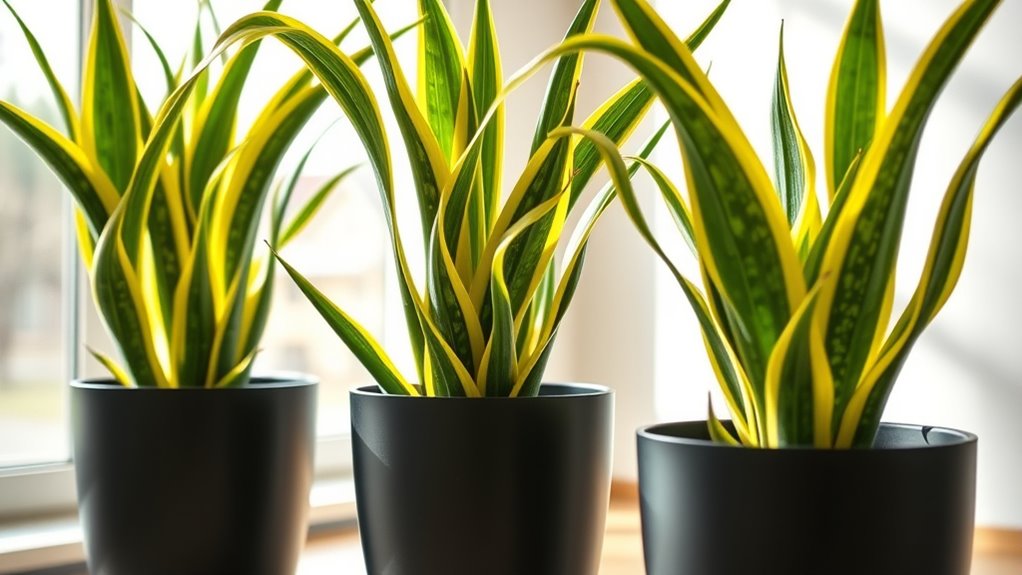
To guarantee your snake plant thrives, it’s important to place it where it can receive about 5-6 hours of indirect sunlight each day.
Suitable placement includes position near east- or west-facing windows, where it can enjoy bright light without direct sun that could scorch its leaves.
While snake plants tolerate low-light conditions, insufficient sunlight slows growth and diminishes their air-purifying benefits.
Aim for good sunlight exposure to meet their light requirements, especially in winter when indoor lighting is weaker.
South- or west-facing windows offer the strongest natural light, promoting vibrant leaf coloration and healthy growth.
Proper window placement ensures your snake plant gets the natural light it needs to flourish, supporting ideal growth conditions indoors.
Proper Watering and Soil Choices

Ensuring your snake plant stays healthy hinges on proper watering and soil choices. Water only when the soil is completely dry, typically every 2-6 weeks, to prevent root rot. Use a well-draining soil mix, like cactus or succulent soil, to allow excess water to drain quickly and keep roots dry. Incorporate sand or perlite into the soil to improve drainage and mimic the plant’s natural arid environment. During winter, reduce watering frequency to about once a month, as growth slows. Make sure your pot has drainage holes to facilitate water runoff and avoid waterlogged soil. Proper watering frequency combined with a soil mix designed for excellent drainage helps maintain healthy roots and prevents overwatering issues. Soil drainage is a critical factor for happy snake plants, and utilizing Automation technologies can also assist in monitoring soil moisture levels to optimize watering schedules. Additionally, choosing the right soil composition can significantly influence the plant’s overall health and growth. Understanding the plant’s native habitat can further guide your soil and watering choices for optimal health. A well-considered watering routine tailored to the plant’s environment will promote lush, healthy growth.
Seasonal Care and Temperature Guidelines
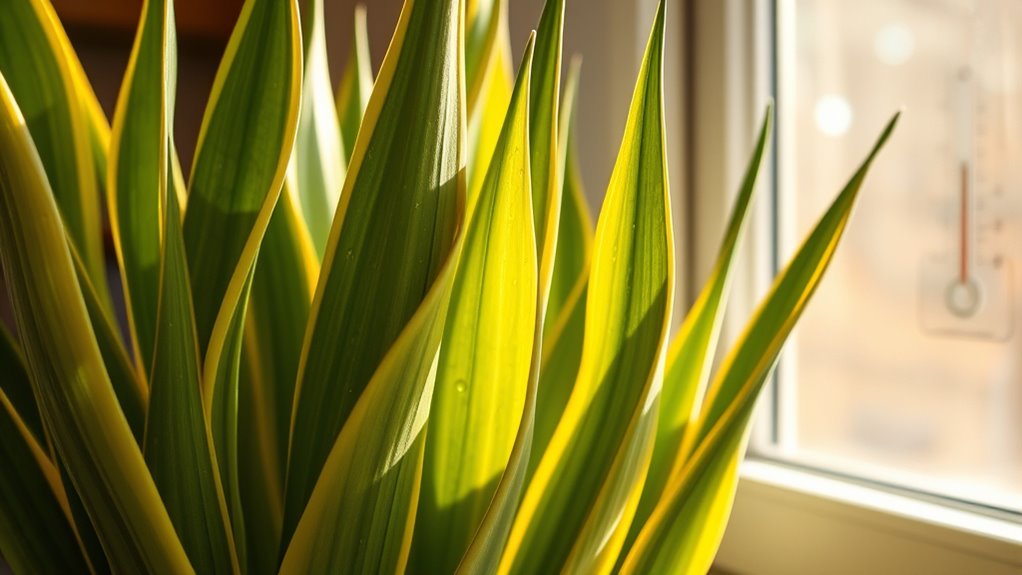
Snake plants perform best when kept within a temperature range of 70°F to 90°F, making them ideal indoor plants. During seasonal changes, follow these temperature guidelines to protect your plant’s health:
- Keep the temperature above 50°F to prevent cold drafts and frost damage.
- Reduce watering frequency to once a month in winter to avoid root rot.
- Maintain indoor humidity around 30-50%, avoiding overly dry or humid environments. Proper temperature regulation is essential for maintaining the plant’s resilience.
During colder months, ensure your snake plant isn’t near air conditioning vents or heating sources, which can cause temperature fluctuations. Temperature stability helps prevent stress and health issues in your plant. Incorporating seasonal adjustments can further support your plant’s adaptation to changing conditions.
Proper winter care involves shielding your plant from sudden temperature drops and maintaining a stable environment. Following these seasonal care tips helps prevent issues like leaf damage and root rot, ensuring your snake plant stays healthy and vibrant year-round. Additionally, understanding plant resilience can guide you in providing optimal conditions for your snake plant’s longevity.
Troubleshooting Common Issues

When your snake plant shows signs of trouble, identifying the underlying issue is key to restoring its health. Overwatering often causes root rot and yellowing leaves; always check that the soil is dry before watering again, typically every 2-6 weeks. Proper watering techniques and understanding soil moisture levels can prevent many common problems. Ensuring proper drainage is essential to avoid water accumulation that can lead to root rot. Insufficient light can slow growth and cause pale leaves, so place your plant near bright, indirect sunlight. Pests like mealybugs or spider mites may infest your plant; treat infestations promptly with insecticidal soap or neem oil. Leaf tips browning or curling might signal low humidity or inconsistent watering—consider increasing indoor humidity or adjusting your watering habits. Cold temperatures below 50°F or drafts in drafty areas can damage the plant. Proper light, watering, and avoiding drafty spots are essential to troubleshoot and prevent these common issues. Additionally, utilizing monitoring devices can help track environmental conditions and prevent future problems. Understanding AI in entertainment advancements can help inform how technology might impact plant care through innovative tools and monitoring devices.
Pet Safety and Responsible Plant Care
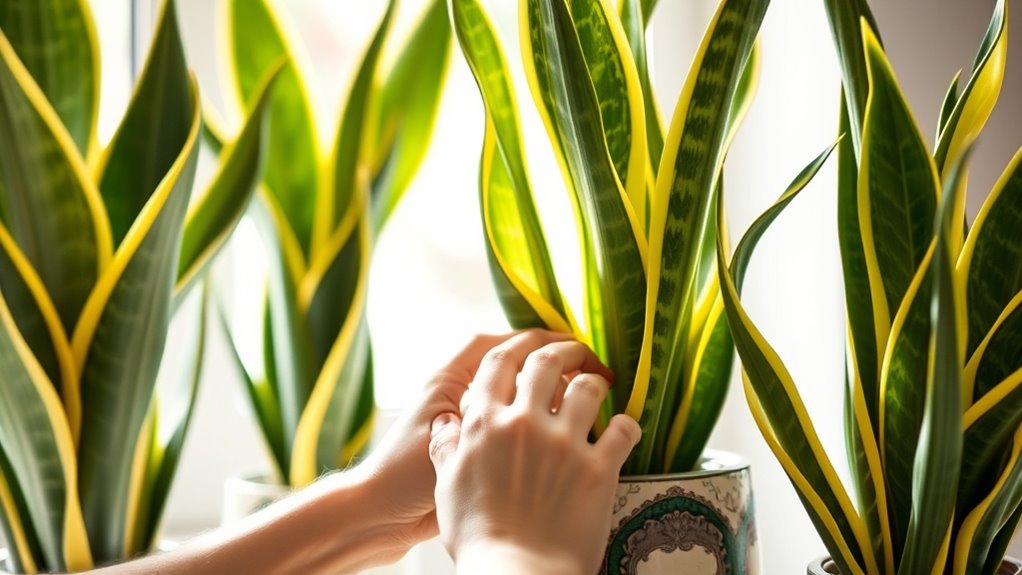
Although snake plants are popular for their air-purifying qualities, they can be toxic to pets if ingested. To guarantee pet safety and responsible plant care, consider these steps:
- Placement: Keep snake plants out of reach of curious animals to prevent accidental ingestion.
- Supervision: Monitor your pets around household plants to catch any signs of plant poisoning early.
- Pet-proofing: Use barriers or elevated containers to minimize risks, especially if your pets tend to chew or swallow household plants.
- Understanding plant toxicity is crucial for responsible plant care, as it helps you recognize potential hazards and take appropriate precautions. Being aware of AI bifurcation concepts can also inform you about future technological changes that might influence pet safety and home management practices. Additionally, understanding local building codes and regulations can help ensure that your home environment remains safe and compliant with safety standards. Furthermore, understanding wall organization systems and their materials can assist in selecting pet-friendly options that reduce clutter and hazards within your living space. Recognizing safety standards in plant packaging and placement can further enhance pet safety measures.
Frequently Asked Questions
Does a Snake Plant Really Purify Air?
Yes, a snake plant truly purifies the air. It absorbs toxins like formaldehyde, benzene, and trichloroethylene through its leaves and releases oxygen, even at night.
You’ll notice it works quickly—within 48 hours, it starts improving your indoor air quality.
Where Should I Place a Snake Plant in My House?
Imagine a lush, upright sentinel in your home, quietly working to improve your air quality.
You should place your snake plant a few feet from east- or west-facing windows, where it can soak up 5-6 hours of filtered indirect sunlight.
Keep it away from direct sun, drafts, or heating vents.
Position it in bright, low, or shaded areas like near north-facing windows or cozy corners for the best results.
How Do I Make My Snake Plant Happy?
To make your snake plant happy, guarantee it gets plenty of indirect sunlight, ideally near east- or west-facing windows.
Water it only when the top inch of soil feels dry, and use well-draining cactus mix to prevent root rot.
Keep the temperature steady between 70°F and 90°F, dust the leaves regularly, and prune damaged leaves.
Fertilize sparingly in spring and summer for healthy, vibrant growth.
How Many Snake Plants Does It Take to Purify a Room?
Think of your room as a battleground against toxins, and snake plants as your silent warriors. Usually, 1 to 2 plants are enough for a standard 150-200 square foot space to see a noticeable difference.
If your space is larger or more polluted, add more plants—about one for every 100 square feet—to maximize air purification. More plants, more clean air, and a healthier living environment.
Conclusion
Caring for your snake plant is more than just routine—it’s nurturing a symbol of resilience and tranquility. When you provide the right light, water, and care, you’re cultivating a quiet strength that cleanses your space and calms your mind. Think of your plant as a steady guardian, silently thriving and transforming your environment into a sanctuary. By tending to it thoughtfully, you’re not just maintaining a plant—you’re fostering a living emblem of peace and perseverance.
